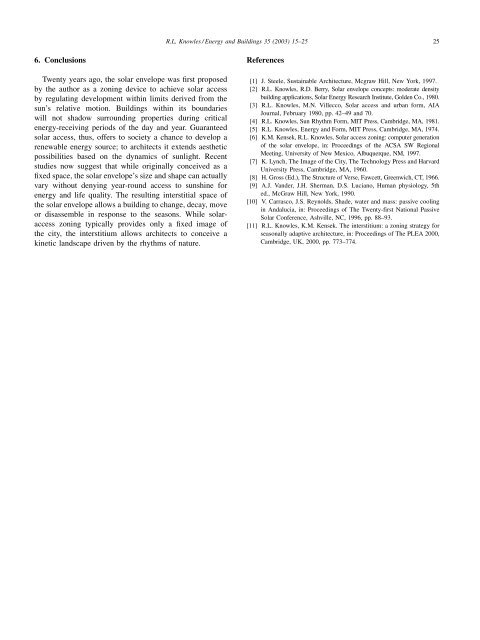The solar envelope: its meaning for energy and buildings
The solar envelope: its meaning for energy and buildings
The solar envelope: its meaning for energy and buildings
You also want an ePaper? Increase the reach of your titles
YUMPU automatically turns print PDFs into web optimized ePapers that Google loves.
6. Conclusions<br />
Twenty years ago, the <strong>solar</strong> <strong>envelope</strong> was first proposed<br />
by the author as a zoning device to achieve <strong>solar</strong> access<br />
by regulating development within lim<strong>its</strong> derived from the<br />
sun’s relative motion. Buildings within <strong>its</strong> boundaries<br />
will not shadow surrounding properties during critical<br />
<strong>energy</strong>-receiving periods of the day <strong>and</strong> year. Guaranteed<br />
<strong>solar</strong> access, thus, offers to society a chance to develop a<br />
renewable <strong>energy</strong> source; to architects it extends aesthetic<br />
possibilities based on the dynamics of sunlight. Recent<br />
studies now suggest that while originally conceived as a<br />
fixed space, the <strong>solar</strong> <strong>envelope</strong>’s size <strong>and</strong> shape can actually<br />
vary without denying year-round access to sunshine <strong>for</strong><br />
<strong>energy</strong> <strong>and</strong> life quality. <strong>The</strong> resulting interstitial space of<br />
the <strong>solar</strong> <strong>envelope</strong> allows a building to change, decay, move<br />
or disassemble in response to the seasons. While <strong>solar</strong>access<br />
zoning typically provides only a fixed image of<br />
the city, the interstitium allows architects to conceive a<br />
kinetic l<strong>and</strong>scape driven by the rhythms of nature.<br />
R.L. Knowles / Energy <strong>and</strong> Buildings 35 (2003) 15–25 25<br />
References<br />
[1] J. Steele, Sustainable Architecture, Mcgraw Hill, New York, 1997.<br />
[2] R.L. Knowles, R.D. Berry, Solar <strong>envelope</strong> concepts: moderate density<br />
building applications, Solar Energy Research Institute, Golden Co., 1980.<br />
[3] R.L. Knowles, M.N. Villecco, Solar access <strong>and</strong> urban <strong>for</strong>m, AIA<br />
Journal, February 1980, pp. 42–49 <strong>and</strong> 70.<br />
[4] R.L. Knowles, Sun Rhythm Form, MIT Press, Cambridge, MA, 1981.<br />
[5] R.L. Knowles, Energy <strong>and</strong> Form, MIT Press, Cambridge, MA, 1974.<br />
[6] K.M. Kensek, R.L. Knowles, Solar access zoning: computer generation<br />
of the <strong>solar</strong> <strong>envelope</strong>, in: Proceedings of the ACSA SW Regional<br />
Meeting, University of New Mexico, Albuquerque, NM, 1997.<br />
[7] K. Lynch, <strong>The</strong> Image of the City, <strong>The</strong> Technology Press <strong>and</strong> Harvard<br />
University Press, Cambridge, MA, 1960.<br />
[8] H. Gross (Ed.), <strong>The</strong> Structure of Verse, Fawcett, Greenwich, CT, 1966.<br />
[9] A.J. V<strong>and</strong>er, J.H. Sherman, D.S. Luciano, Human physiology, 5th<br />
ed., McGraw Hill, New York, 1990.<br />
[10] V. Carrasco, J.S. Reynolds, Shade, water <strong>and</strong> mass: passive cooling<br />
in Andalucia, in: Proceedings of <strong>The</strong> Twenty-first National Passive<br />
Solar Conference, Ashville, NC, 1996, pp. 88–93.<br />
[11] R.L. Knowles, K.M. Kensek. <strong>The</strong> interstitium: a zoning strategy <strong>for</strong><br />
seasonally adaptive architecture, in: Proceedings of <strong>The</strong> PLEA 2000,<br />
Cambridge, UK, 2000, pp. 773–774.
















